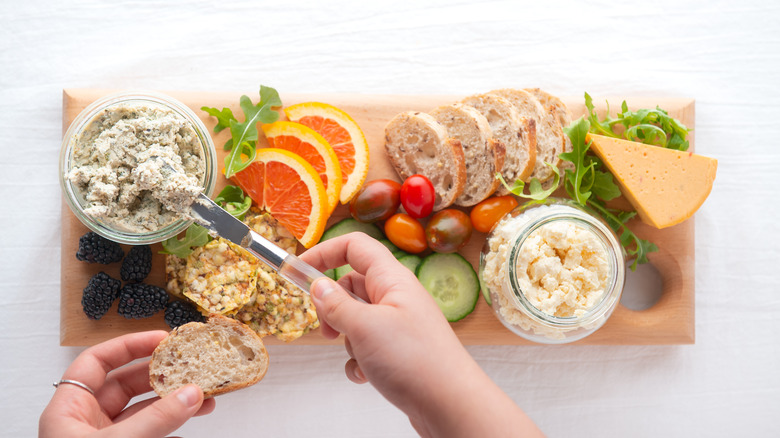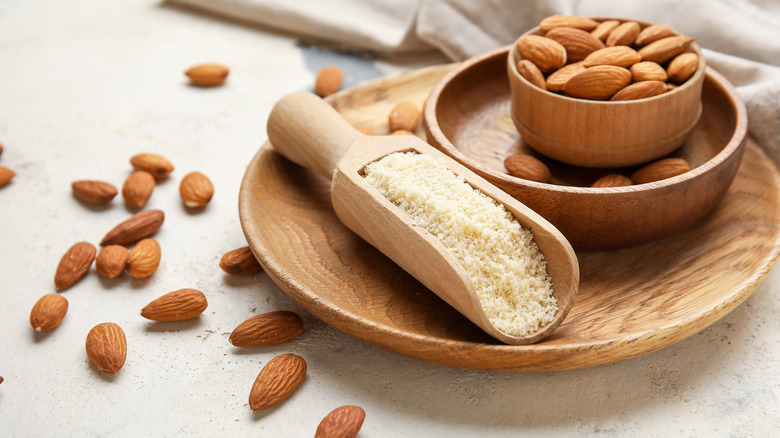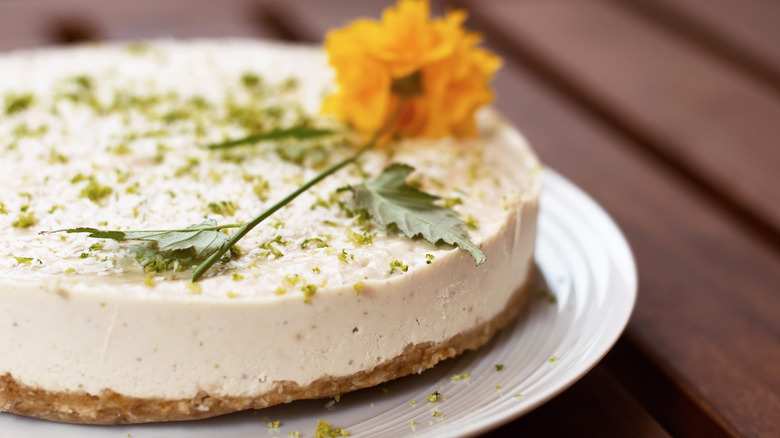Make Your Next Vegan Cheese Out Of Almonds. You Won't Regret It
Today, in most supermarkets across the country, you can find vegan alternatives to almost everything, from burgers and ice cream to chicken wings, roasts, and hot dogs. However, not all vegan food products are created equal — especially cheese. While some vegan cheese brands are better than others, if you want a product that suits your tastes and needs, it might be time to try making it yourself.
Like traditional cheeses, vegan cheeses come in all shapes and sizes and can be made from any number of ingredients. Cashews, soy milk, tofu, tapioca flour, and nutritional yeast have risen to the top of the pile in terms of non-dairy cheese alternatives, but that doesn't mean you should overlook a more common ingredient that may be floating around your pantry right now — almonds.
Using almonds as the base of your vegan cheese results in a smooth yet firm texture and a mild flavor that's great for bagels, pasta dishes, and desserts. And, of course, a log of homemade almond cheese rolled in nuts or dried fruit can serve as a stunning centerpiece for your dairy-free cheese board.
Why almonds make good vegan cheese
Almonds are a great option for your next back of homemade vegan cheese for a few reasons. The first — and arguably most important — is that almond cheese looks the part. We eat with our eyes, and you'll want your non-dairy cheese to be pale in color, smooth, and compact. After they've been blanched and had their skins removed, almonds are the perfect shade of creamy white, making them similar in appearance to mozzarella, cheddar, and goat cheese — to name a few.
Equally important to your vegan cheese is its texture. Unlike blanched cashews, which come out silky and smooth after blending, almonds emerge from the food processor a bit coarser, resulting in a non-dairy cheese with more structure and shape. That means you can easily mold it into faux-goat cheese logs or blocks of non-dairy feta.
Finally, there's the taste. Almonds are mild in flavor, making them the perfect vessel for different spices, seasonings, herbs, and marinades. If you want a tangier cheese, like feta, add some lemon juice; if you want a cheese with a bit more umami flavor, fold in some miso or nutritional yeast.
Ways to use your vegan almond cheese
Although almond cheese may not have the same melting/stretching properties as traditional cheeses, there's still a ton you can do with it besides making it the focal point of your next vegan charcuterie board or an offering at your next vegan holiday celebration.
The soft-yet-crumbly texture of almond cheese makes it a terrific option for vegan ravioli or manicotti filling. Heighten its flavor by adding some fresh lemon zest or basil. Staying with the Italian theme, you can also use almond cheese instead of ricotta as a layer in vegan lasagna. If you love vegan comfort foods, try slathering a couple of tablespoons of almond cheese between two slices of bread for a vegan grilled cheese. The same technique works for quesadillas, too.
If you've made an almond cheese that doesn't include tons of savory seasonings and is more neutral in flavor, try incorporating it into desserts. Use it as the base of a raw vegan cheesecake, or fold in some confectionary sugar and pipe your almond cheese into a pastry shell for a dairy-free cannoli. You can do a lot of experimenting with almond cheese, and that's the most exciting part! Who doesn't love to play around with their food?


